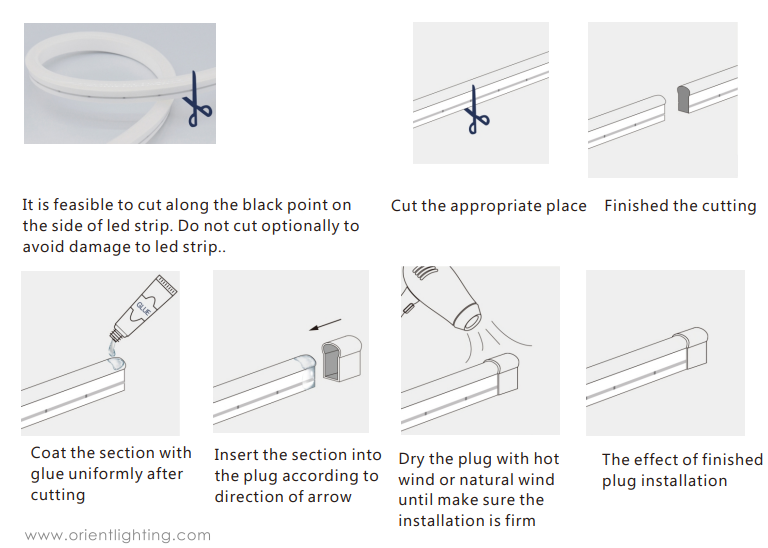Views: 0 Author: Site Editor Publish Time: 2025-07-03 Origin: Site
Flexible LED strip lights have rapidly gained popularity in both residential and commercial lighting applications. Their versatility, energy efficiency, and ease of installation make them an excellent choice for accent lighting, decorative purposes, and practical illumination alike. From highlighting architectural features to providing under-cabinet lighting, flexible LED strips can adapt to nearly any environment or design concept.
One common reason users turn to flexible LED strips is their customizable length. Unlike rigid lighting fixtures, LED strips can be cut to fit specific spaces, allowing for a seamless, tailored lighting experience. Whether you're a DIY enthusiast, an interior designer, or an installer, understanding how to safely and effectively cut LED strip lights is crucial to maximize their potential and avoid costly mistakes.
Before diving into cutting techniques, it is important to understand the basic structure of flexible LED strip lights and how cutting impacts their functionality.
A typical flexible LED strip consists of three main components:
LED Chips: These are tiny light-emitting diodes mounted along the strip at regular intervals. Depending on the strip’s design, these may be single-color LEDs or multi-color RGB/RGBW LEDs.
Copper Foil Circuitry: This acts as the electrical backbone of the strip, connecting each LED in series or parallel. The copper traces carry power and signals to the LEDs.
Protective Layer: Most strips are coated with a thin layer of silicone or epoxy to shield the electronics from dust, moisture, and mechanical damage. Some strips have an additional waterproof layer or silicone tubing.
Because the LEDs and circuits are fixed at precise points, any cutting outside designated areas risks severing electrical connections. This can lead to broken circuits, sections of the strip failing to light, or even short circuits that pose safety hazards.
The short answer is yes, you can cut flexible LED strip lights—but only at specified cutting points.
Designated cut points are usually clearly marked on the strip itself. These marks are often indicated by:
Scissor icons printed directly on the strip.
Lines or gaps between copper pads on the circuit.
Small dotted or solid lines running perpendicular to the strip length.
Cutting along these marks preserves the continuity of the circuit, ensuring the remaining strip segments continue to operate correctly.
Cutting anywhere else risks damaging the copper circuitry, which may cause the strip to stop working or behave unpredictably. Improper cutting can lead to open circuits (no lighting in that segment) or short circuits (potential overheating or fire hazard).
It is critical to only cut along the manufacturer’s recommended cut points. High-quality strips, such as those from ORIENT LIGHTING, feature clearly labeled and easily identifiable cutting areas to facilitate safe customization.

Before making any cuts, carefully examine your LED strip to locate the designated cut points. These are usually spaced every 3, 5, or 10 centimeters depending on the strip type and LED spacing.
Look for:
Scissor icons or dotted lines printed on the strip surface.
Copper pads grouped in pairs or triples — these indicate where power connections are designed to be severed safely.
Never guess or cut randomly—incorrect cutting can ruin the entire strip.
For the cleanest and safest cuts, use appropriate cutting tools such as:
Sharp scissors: Small, sharp scissors can make a clean cut along the designated lines.
Craft knife or utility blade: Useful for more precise cuts or trimming.
Dedicated LED strip cutters: Some specialized tools are designed to cut LED strips without damaging circuits.
Avoid using dull blades, as they can crush the circuitry or cause uneven edges.
Turn off and unplug the strip light before cutting to avoid electric shock or damage.
Lay the strip flat on a stable surface with good lighting to clearly see the cut marks.
Align the cutting tool with the marked cut line, ensuring precision.
Make a clean, steady cut through the strip at the designated point.
Inspect the cut edge to confirm no damage occurred to adjacent circuitry or copper pads.
By following these steps, you maintain the integrity of the strip and avoid future electrical issues.
Often, after cutting, you will want to reconnect the segments or connect the cut piece to a power supply. There are two main methods:
Using Connectors:
No-solder connectors: These clip onto the cut ends, making a quick and easy connection without special tools. Ideal for beginners or temporary setups.
Solderless snap connectors: These fasten securely and maintain reliable electrical contact.
Pros: Quick, clean, and beginner-friendly.
Cons: Slightly less durable than soldered joints and can add bulk.
Soldering:
Solder wires or connector pins directly to the copper pads for a permanent and robust connection.
Pros: More durable and lower resistance connection.
Cons: Requires tools and soldering skills.
The choice depends on your project, tools available, and durability needs.
If your LED strip is waterproof or designed for outdoor use, proper sealing is critical after cutting.
Use waterproof end caps, silicone glue, or heat shrink tubing to seal cut ends.
This prevents moisture, dust, or debris from entering and damaging the internal circuitry.
Failure to properly insulate can lead to corrosion, short circuits, and premature failure.
Cutting outside designated lines: Always cut only at marked points. Guesswork leads to broken circuits.
Ignoring insulation on waterproof strips: Always reseal cut ends to maintain waterproofing.
Using blunt or inappropriate tools: Dull blades crush circuits; improper tools cause jagged edges.
Pulling or bending strips harshly near cut ends: Can damage solder joints or copper pads.
Always disconnect power before cutting or handling LED strips.
Use personal protective equipment like gloves and eye protection when soldering.
Do not exceed the power supply’s rated voltage and current to avoid overheating.
Ensure connections are secure to prevent sparks or shorts.
Cutting flexible LED strip lights allows for highly customizable lighting installations tailored to any space or design need. When done correctly—cutting only at designated points, using the right tools, and properly reconnecting and sealing the strips—cutting enhances the flexibility and usability of these versatile lighting solutions.
For the best experience, choose high-quality, clearly marked LED strips from reputable suppliers such as ORIENT LIGHTING Co., Ltd. Their products are designed with user-friendly cut points and robust materials to ensure safety and longevity.
If you’re planning a project involving flexible LED strips and need guidance on cutting, installation, or customization, consider contacting ORIENT LIGHTING for expert advice and premium products. Professional support helps you get the perfect lighting effect while maintaining safety and reliability.
INTEGRATE™ is a series of integrate flexible LED strips including single White, single Color, variable white, RGB, RGB pixel, RGBW and RGBVW. Various types would meet any your customized requirements. Integrate has dome surface as COB for soft and dot-less effect, same SMD technology as lighting sou
Flexible SMD LED strip lights have become one of the most popular lighting solutions in both residential and commercial environments. Their slim profile, low power consumption, and versatility make them suitable for accent lighting, task lighting, decorative installations, and even large-scale architectural illumination. Among the wide range of LED chips available today, SMD 3528 and SMD 5050 remain two of the most commonly used and widely recognized options.
SMD LED strip lights have become one of the most versatile and popular lighting solutions in modern homes, commercial environments, and creative projects. Their slim profile, flexible design, and energy efficiency make them ideal for accent lighting, task lighting, ambient illumination, and decorative installations. Yet one of the biggest questions users have—especially beginners—is whether SMD LED strip lights can be cut without damaging them.
LED strip lighting has become one of the most versatile and widely adopted solutions for modern residential, commercial, and architectural lighting. Among the different types of LED strips available today, SMD LED strip lights and COB LED strips are the two most popular choices. Each offers unique advantages, performance characteristics, and visual effects, making them suitable for different applications.
SMD LED strip lights have become one of the most versatile and widely used lighting solutions for residential, commercial, and industrial applications. From accent lighting in living rooms to large architectural installations and retail displays, LED strips offer flexibility, efficiency, and precise illumination control. However, managing long LED strips—especially those stretching beyond 5–10 meters—comes with unique challenges.
LED lighting has revolutionized the way homes, commercial spaces, and decorative environments are illuminated. Among the most popular modern lighting solutions, LED flexible strip lights stand out because they combine versatility, energy efficiency, and sleek aesthetics. Within this category, SMD LED strip lights have become the industry standard due to their compact size, strong brightness, and adaptability to a wide range of applications.
In the world of modern lighting, few products have transformed interior and exterior illumination as dramatically as SMD LED strip lights. Whether used for home decoration, retail ambiance, architectural highlights, or industrial applications, these flexible and efficient lighting tools offer unparalleled versatility. Their slim design, excellent brightness, and wide color options have made SMD LED strips a preferred choice for designers, homeowners, and engineers alike.
Light and color have long been understood to influence human emotions, behavior, and even physical well-being. From the moment we wake up to the time we go to sleep, the type of light surrounding us plays a vital role in shaping our moods, productivity, and overall state of mind. This is why understanding the psychology of light and color is crucial when selecting LED lighting for various environments, whether it's at home, in the office, or in commercial settings.
LED strip lights are a popular choice for modern lighting due to their energy efficiency, versatility, and sleek design. However, one crucial aspect that is often overlooked when using LED strips is thermal management. LED lights, like any other electronic component, generate heat as they operate, and if not properly managed, this heat can reduce their performance and lifespan.
Choosing the right LED strip lights for your home or office is a decision that requires careful consideration. LED strips have become an increasingly popular choice due to their versatility, energy efficiency, and aesthetic appeal. However, with so many options available on the market, it’s easy to feel overwhelmed by the number of different types and features.
Indirect lighting has become a popular choice for creating a soothing and stylish ambiance in both residential and commercial spaces. Unlike direct lighting, which often creates harsh shadows and bright spots, indirect lighting provides a more gentle and even illumination that enhances the atmosphere without overwhelming the eyes.
Proper lighting on boats or yachts is not just about enhancing the aesthetic appeal; it plays a crucial role in ensuring safety, functionality, and comfort on the water. Effective lighting can help improve visibility during nighttime navigation, set the mood for evening activities, and highlight specific areas of your vessel. One of the best lighting options for marine environments is LED strip lights. Their versatility, energy efficiency, and durability make them an excellent choice for a variety of marine applications.
To ensure that your LED strip lights continue to perform at their best and last as long as possible, proper care and installation are essential. LED strips are known for their longevity and energy efficiency, but several factors can influence how long they last. By following some simple yet effective maintenance tips, you can extend the lifespan of your LED strips and keep them running smoothly for years to come.
When purchasing LED strip lights for your home or business, you might notice various certifications listed on the product packaging or technical specifications. These certifications, often represented by logos or marks, indicate that the product has met specific safety, environmental, and quality standards. Understanding what these certifications mean can help you make informed decisions, ensuring you choose a reliable and safe lighting solution.
LED strip lights are a fantastic way to add vibrant lighting to your home or workspace, offering versatility and energy efficiency. However, when it comes to installation, there are common mistakes that many people make, which can negatively affect the performance, lifespan, and overall functionality of the LED strips. Whether you're a seasoned DIYer or a first-time installer, it's crucial to avoid these common errors to ensure your LED lights shine brightly and last for years to come.
Flexible lighting strips, commonly known as LED strips or tape lights, have revolutionized the way we illuminate spaces. Their adaptability, energy efficiency, and vibrant lighting options make them popular choices for a wide variety of applications—from home decor to commercial advertising and industrial uses.
In recent years, flexible lighting strips have become increasingly popular not just for indoor use, but also as a creative and practical solution for outdoor lighting applications.
Flexible LED strip lights have rapidly gained popularity in both residential and commercial lighting applications. Their versatility, energy efficiency, and ease of installation make them an excellent choice for accent lighting, decorative purposes, and practical illumination alike.
Flexible lighting strips, commonly known as LED strip lights, are thin, versatile lighting fixtures that consist of small light-emitting diodes (LEDs) mounted on a flexible circuit board.
In the world of modern lighting, flexible lighting strips—also known as LED strip lights or ribbon lights—have revolutionized how we illuminate spaces. These thin, adaptable lighting solutions offer not only energy efficiency but also unmatched versatility, making them a top choice for a wide range of residential, commercial, and industrial applications.


